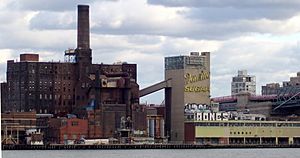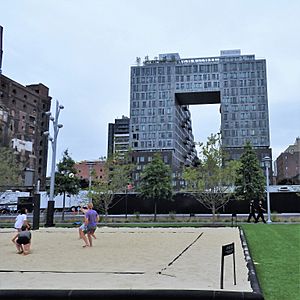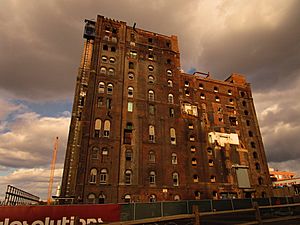Domino Sugar Refinery facts for kids

The refinery seen in 2012; the filter, pan, and finishing house (left) is still standing, while ancillary structures (right) have been demolished
|
|||||||||||||||||
| Location | Brooklyn, New York | ||||||||||||||||
|---|---|---|---|---|---|---|---|---|---|---|---|---|---|---|---|---|---|
| Address | Kent Avenue | ||||||||||||||||
| Coordinates | 40°42′52″N 73°58′03″W / 40.71444°N 73.96750°W | ||||||||||||||||
| Status | Under construction | ||||||||||||||||
| Estimated completion | 2025 | ||||||||||||||||
| Opening |
|
||||||||||||||||
| Use | Mixed-use | ||||||||||||||||
| Companies | |||||||||||||||||
| Architect |
|
||||||||||||||||
| Developer | Two Trees Management | ||||||||||||||||
| Planner | SHoP Architects | ||||||||||||||||
| Technical details | |||||||||||||||||
| Cost | $3 billion | ||||||||||||||||
| Buildings | 5 | ||||||||||||||||
| Leasable area | 600,000 square feet (56,000 m2) of office space, 200,000 square feet (19,000 m2) of retail space | ||||||||||||||||
|
|||||||||||||||||
The Domino Sugar Refinery is a large building complex in Williamsburg, Brooklyn, New York City. It sits right along the East River. For many years, it was a huge factory that made Domino brand sugar. It was one of several sugar factories in northern Brooklyn.
The first sugar factory here opened in 1856. It was run by Frederick C. Havemeyer Jr., whose family started the American Sugar Refining Company. A big fire destroyed the original buildings in 1882. After the fire, the current main building was built. The American Sugar Refining Company became very powerful. By the late 1800s, it controlled most of the sugar industry in the United States. The Brooklyn factory was its biggest plant. It made many kinds of sugar and employed up to 4,500 workers in 1919. The factory kept working until 2004.
In the early 2000s, the old refinery area was turned into new buildings. These new buildings include offices, homes, and a public park. In 2007, the main factory building, called the Filter, Pan, and Finishing House, became a special New York City designated landmark. This means it's protected because of its history. A new plan for the site was approved in 2014. Old buildings that were not landmarks were torn down. The first new building opened in 2017. As of 2024, the area has four completed towers, the old Refinery building, and a park called Domino Park.
The Sugar Factory's History
Brooklyn's waterfront became a busy industrial area in the 1800s. Places like the Brooklyn Navy Yard and Industry City were built. The village of Williamsburgh, where the refinery is, grew quickly after becoming part of Brooklyn in 1855.
The Havemeyer family, who were German immigrants, started their first sugar factory in Manhattan in 1807. Frederick C. Havemeyer Jr. helped the family business grow into a huge sugar company.
First Factory Buildings
The Havemeyer family's Manhattan factory became too small by the mid-1800s. So, John C. Havemeyer, Frederick Jr.'s nephew, opened a new factory in Williamsburg in 1856. This factory was called Havemeyers & Elder. It was the largest of the Havemeyer family's plants. The complex included a five-story building and other smaller buildings.
Many other sugar factories were built in Williamsburg. This made it the world's biggest sugar-refining center at the time. By 1870, Williamsburg made most of the sugar used in the United States. By 1881, the Havemeyer factory processed about three-quarters of all refined sugar in the country. Big ships carrying raw sugar could come right up to the factory because the East River was deep there.
Rebuilding After the Fire
The original factory burned down on January 8, 1882. The fire destroyed many buildings and caused about $1.5 million in damage. This led to 1,200 to 2,000 people losing their jobs. The destruction also made sugar prices go up across the country.
In February 1882, the Havemeyer family bought another factory in Brooklyn. This allowed them to keep making sugar while the new factory was being built. The next month, plans were made for a new, fireproof building. Theodore Havemeyer oversaw the construction. The rebuilding was finished by July 1883. The total cost was about $7 million.
How the Factory Worked
The new factory was very large and gave the Havemeyer family a big advantage. By 1884, it employed 1,000 men and made 5,000 barrels of sugar every day. In 1887, the family created the Sugar Refineries Company, also known as the Sugar Trust. This trust controlled 98% of sugar production in the U.S. In 1891, it became the American Sugar Refining Company.
By 1894, the plant was called "the largest of its kind in the world." It had seven buildings and employed 3,000 workers. It used 800 tons of coal daily and produced 13,000 barrels of sugar each day. In 1896, American Sugar became one of the first companies in the Dow Jones Industrial Average. In the early 1900s, the company changed its name to "Domino's Sugar."
The factory refined many types of sugar. Raw sugar came from many countries. It was unloaded from ships, mixed with water, and then strained. The mixture was filtered through special materials like "bone black" and canvas. Then, it was boiled in large vacuum pans. After that, machines called centrifuges separated the sugar from molasses. Finally, the sugar grains were dried and packed into barrels. These barrels were stored in nearby warehouses.
Working conditions at the factory were tough. Workers were paid little, even though they worked at least ten hours a day. At first, most workers were German immigrants. Later, immigrants from other parts of Europe and the West Indies were hired. Workers earned between $1.12 and $1.50 per day in 1894. Conditions improved in the early 1900s with better wages and some pensions. Most employees were men, but by 1920, about one in ten workers were women.
Later Years and Closure
In 1907, American Sugar built a railroad to move sugar between the factory and a nearby terminal. In 1917, during World War I, an explosion damaged part of the plant. Six to twelve workers died. People first thought it was German agents, but it was found to be sugar dust catching fire in the machines.
By 1919, the factory had over 4,500 employees. The company tried to close some local streets to expand the factory, but local people opposed it. In 1924, the company even threatened to move to New Jersey. The city government eventually allowed them to close some streets.
In 1926, American Sugar started a big renovation of the plant. They built a new dock, a boiler house, and a large warehouse. These upgrades cost $3 million and made the factory more efficient. Around this time, a huge yellow "Domino Sugar" sign was put on one of the buildings facing the East River. By 1941, the factory made 60 types of sugar. It was a major part of Brooklyn's economy.
Decline and Closing
Changes in the sugar industry led to less use of the Brooklyn factory. After American Sugar opened a plant in Baltimore in 1922, less refining was done in Brooklyn. The number of workers fell after World War II. By 1959, there were 1,500 workers. In 1970, American Sugar was renamed Amstar. By the late 1970s, the Amstar refinery was the only sugar factory left on the Williamsburg waterfront.
In 1988, a British company bought the Amstar brand. Three years later, Amstar became known as Domino Sugar. The number of workers kept going down. By 1996, only 450 people worked there. In 1999, 284 workers went on strike because of job cuts. The strike lasted until 2001. Even though some workers returned, 110 jobs were still cut. Another company bought the brand and plant that same year.
By 2002, the factory was only processing half the sugar it could. In 2003, American Sugar Refining announced the plant would close due to low demand. The factory stopped working in 2004. More than 220 workers lost their jobs.
New Plans for the Site
First Ideas
In 2004, a company called CPC Resources bought the 11-acre site for $55.8 million. In 2005, the waterfront area was rezoned. People who wanted to save old buildings pushed to protect the Domino Sugar Refinery. In 2007, the main factory building (Pan, Filter, and Finishing House) was made a city landmark. The developers wanted to keep the famous yellow "Domino Sugar" sign on top of it.
CPC's first plan included up to nine buildings, with 2,200 apartments. Some of these would be affordable homes. The plan was approved in 2010. But local residents didn't like how big the buildings would be. In 2012, CPC couldn't continue the project. Another company, Two Trees Management, bought the site for $185 million in October 2012.
New Design Plan
Two Trees presented a new design plan in 2013. This plan included more public park space and connected the area to the waterfront. It still had 2,200 apartments, with 660 being affordable. But it also proposed buildings up to 50 stories tall, which would be some of Brooklyn's tallest. Some residents still opposed it, but less so after Two Trees agreed to add more affordable housing and parkland.
In March 2014, the city approved the new plans. The project would cost $1.5 billion. Two Trees agreed to include 700 affordable housing units. In return, they could build towers up to 55 stories high. They also planned to add three floors on top of the old factory building.
Building the New Domino
In 2014, demolition of the non-landmark parts of the refinery began. Most of it was done by December 2014. Construction for the first new building, 325 Kent Avenue, started in May 2015. Two Trees also cleaned out the old Pan, Filter, and Finishing House. In February 2017, a lottery was held for the 104 affordable apartments at 325 Kent Avenue. About 87,000 people applied! 325 Kent Avenue opened in July 2017.
A second residential building, 260 Kent Avenue, started construction in early 2018. Domino Park, a public park along the waterfront, opened in June 2018. Two more towers, One South First and Ten Grand, opened in late 2019. The first office tenant moved into Ten Grand in December 2019. During the COVID-19 pandemic, Two Trees leased space to many local companies.
By early 2021, the old Pan, Filter, and Finishing House, now called the Refinery, was being renovated. In early 2022, another affordable housing lottery opened for One South First. Work on 346 Kent Avenue (now One Domino Square), two towers at the south end, began in November 2022. The Refinery building's new roof was finished by late 2022. An LED copy of the old "Domino Sugar" sign was put on the building in December.
The renovated Refinery building officially reopened on September 27, 2023. Two Trees offered tax breaks to companies moving there from Manhattan. Sales for homes at One Domino Square began in April 2024, and the building opened in June 2024. The Domino Square plaza opened in September 2024. A housing lottery for One Domino Square's rental apartments opened in October 2024. By late 2024, some of the condos in One Domino Square had been sold, but only a quarter of the Refinery building's office space was rented. By mid-2025, almost half of One Domino Square's condos were sold.
New Buildings and Parks
The Domino Sugar Refinery site covers 11 acres along the East River. When finished, it will have 200,000 square feet of community and retail space. It will also have 600,000 square feet of office space. There will be 2,800 apartments, with 700 of them being affordable. Plus, there will be 6 acres of parkland along the waterfront, which is part of Domino Park. The whole project will have five residential buildings and cost $3 billion.
Homes and Offices
325 Kent Avenue
325 Kent Avenue is a 16-story building. It has 522 homes, and 105 of them are affordable. The homes range from small studio apartments to two-bedroom apartments. The building has a rooftop deck, a gym, a lounge, and a courtyard.
The bottom part of the building is made of copper, and the top part is zinc. The building looks like two towers that step down. The tops of the two parts connect, making a "doughnut" shape with a hole in the middle.
One South First and Ten Grand
The 45-story One South First tower and the 24-story Ten Grand tower are next to the old Refinery building. One South First has 330 homes, with 66 being affordable. Ten Grand has 15,000 square feet of shops and 150,000 square feet of office space. These buildings share amenities like a rooftop deck, a gym, a pool, and coworking spaces.
The buildings are connected. The upper floors of One South First extend over Ten Grand. The outside of the buildings is made of concrete panels. The architects said these panels were inspired by the shape of sugar crystals.
One Domino Square
One Domino Square has two towers rising from a shared base. It has 160 condos and about 400 rental apartments. About 120 of the rental apartments are affordable homes for lower-income residents. The condo tower is 39 stories tall, and the rental tower is 55 stories tall. The outside of both towers is covered in shiny porcelain tiles.
The two towers together have over 700,000 square feet of space. The bottom part has shops. There are 45,000 square feet of amenity space on five floors. These include terraces, a gym, coworking space, and a spa. The condos have features like movable windows and high ceilings.
Parks and Public Spaces
Domino Park runs along the East River waterfront. This public park includes old machinery from the factory. It also has gardens, a play area for kids, and open fields. A raised walkway goes along the park.
Just south of the Refinery building is Domino Square. This is a 1-acre public plaza shaped like an oval bowl. It has 120 plants, including pines, oaks, and flowers. The plaza can be used for events or even as an ice rink in winter. Shops are located around the plaza.
The Old Refinery Building
When the refinery was rebuilt in 1882–1883, it was made of several buildings. It was known as the largest sugar refinery in the Americas. Today, only the Pan, Filter, and Finishing House remains. This building is a New York City landmark.
Pan, Filter, and Finishing House
The Pan, Filter, and Finishing House (also called the Refinery building) is 10 to 13 stories tall. It was one of the tallest buildings in Brooklyn when it was built.
The building is mostly made of reddish brick. The walls are very thick. The outside has decorative brick patterns. Most windows have brick arches. The building used coal for power, so it had a 155-foot-tall chimney. This chimney was one of the tallest in the area.
In 2017, plans were made to turn the building into offices. A new glass structure with a curved roof was added behind the old brick walls. This glass roof is 235 feet tall. The shape of the roof was inspired by the arched windows of the original building.
Inside the Building
The inside of the building was converted into 460,000 square feet of office space. The ground floor has shops and restrooms for park visitors. There's also a 40,000-square-foot fitness club with a gym and pool. Floors 2–13 are offices. The 14th floor has a large event space. The new glass office structure is set back 10 feet from the old brick walls. There's also a wall garden between the old and new parts.
Former Buildings
Other buildings at the refinery included the Syrup Shed, Wash House, and Power House. Large cranes on the waterfront unloaded sugar from ships. There was also a "bin structure" where sugar grains were sorted. A famous yellow "Domino Sugar" sign hung on one of the buildings. In December 2022, a new LED copy of this sign was put on the Pan, Filter, and Finishing House.
The refinery used huge amounts of water. In 1903, it was estimated that the factory used two percent of Brooklyn's entire water supply!
See also





